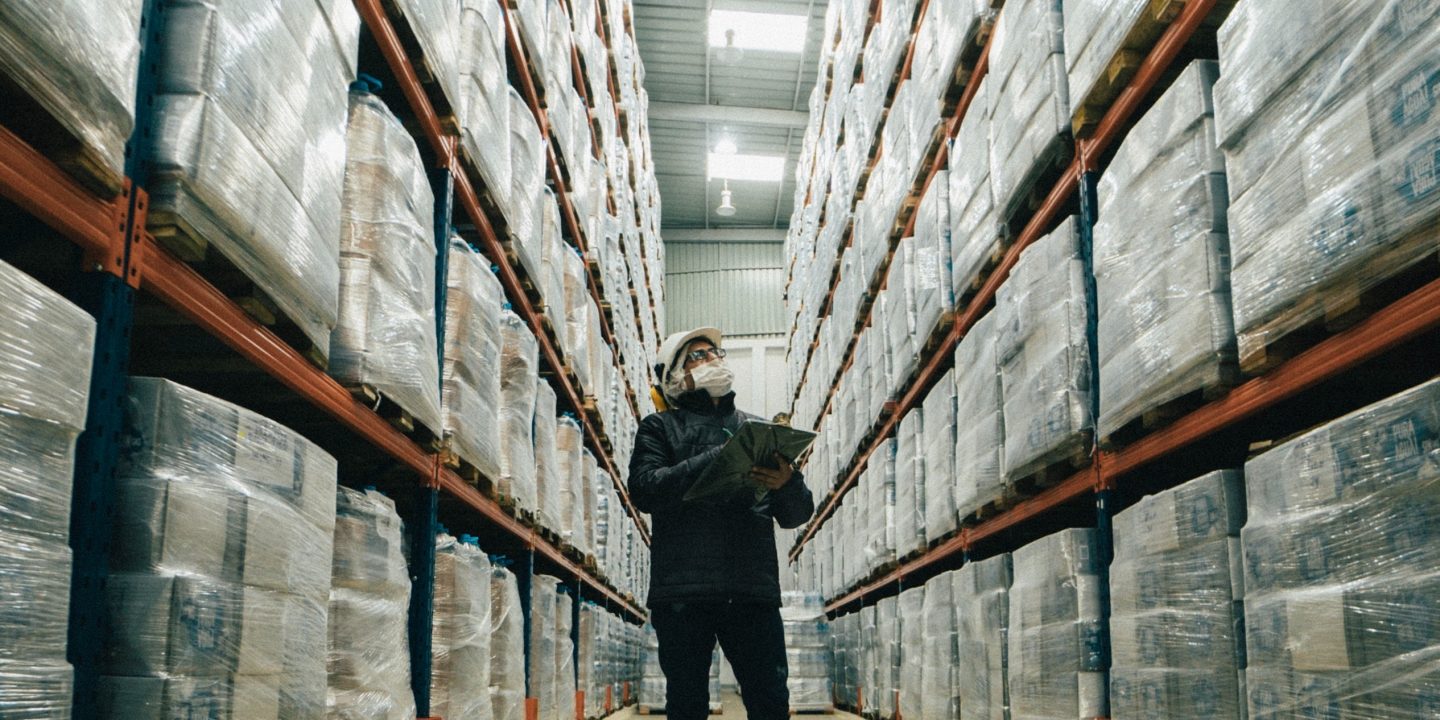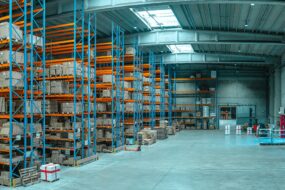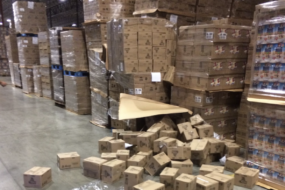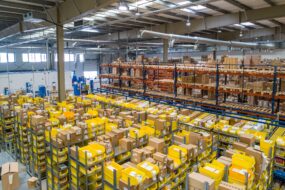Contents

A vital part of the retail supply chain, warehousing solutions and logistics are essential for inventory storage and efficiently delivering and fulfilling customer orders.
As technology has advanced and e-commerce is even bigger than ever, warehousing solutions have also had to evolve. Inbound and outbound logistics need to be considered in a retail business, and warehousing plays an important role.
What Is Warehousing?
Warehousing is the storage of physical product, or inventory, with the intent to sell it. A warehousing solution will process inventory coming in and store it in a safe, secure, and organized fashion. This solution will also be prepared to move products out quickly when orders come in.
Items are organized, so they are easily accessible and can be quickly sent out. A warehouse provides a physical space to store and ship inventory from.
A warehouse differs from storage. Warehousing is meant to be a temporary solution, while storage is more long term. With storage, items are placed for safe keeping and do not need to be accessed regularly.
A warehouse, on the other hand, should be prepared to move inventory quickly and constantly. A warehouse is a bustling environment that can manage a high volume of products. With good processes, a warehouse can help ensure efficiency with retail operations and getting physical product from the seller to the consumers.
Warehousing Solutions
Warehousing solutions can range from storing product personally and managing orders yourself to renting out a storage space where this takes place to leasing or renting a space in a warehouse. A warehousing solution can also provide fulfillment services and ship products directly to customers.
A warehousing solution can provide you with several benefits:
- Physical space to store inventory
- Safe and secure location
- Inventory tracking (the ability to quickly access products, record when the items arrived and how long they have been there, and keep track of the quantity on hand)
- Logistics support
- Allows for quick movement of product for high customer satisfaction rates
- Enables efficiency of order fulfillment
A fulfillment center is a type of warehousing solution that bridges the gap between seller and customer. A traditional warehouse is used to store goods until they are ready to be moved, while a fulfillment center will quickly be turning over product as orders come in. A 3PL (third-party logistics) can handle warehousing solutions and offer a variety of services to help streamline retail and e-commerce businesses, providing efficient order fulfillment.
Logistics of Warehousing
Retail businesses that sell physical products will rely on warehousing logistics to ensure that products can be quickly and efficiently sent through the supply chain to get orders from seller to customer. Warehousing logistics include the day-to-day running of operations at the physical warehouse, the managing of these operations, and tools for managing warehouse operations.
Warehouse Operations
Warehouse operations include all of the necessary processes that it takes to keep things running smoothly. This will involve the daily functions that are required for moving goods and tracking inventory. This can include the following:
- Receiving inventory
- Sorting products by SKU and placing each different SKU in a designated storage area
- Picking product
- Sending it to the next location
Warehouse Management
Warehouse management involves managing the warehouse and the daily operations. This can include staffing, staff training, overseeing inventory, ensuring proper safety and security, performing warehouse audits as needed, maintaining regulatory compliance, ensuring staff members have the required equipment licensure and certifications, warehouse slotting, and solidifying relationships with shipping carriers.
Warehouse Management System (WMS)
A warehouse management system (WMS) can eliminate manual processes and streamline warehousing logistics. A WMS is software that can help to manage warehouse operations. This can optimize the distribution of the workload and daily warehouse operations, and it can provide efficient measures for tracking, picking, and shipping products.
A WMS can decrease potential inefficiencies in warehouse operations. It can also directly impact profit margins and the customer experience.
Warehousing Within the Supply Chain
Goods and raw materials are often ordered from overseas. When they are shipped over, they are often stored in a warehouse. The warehouse can provide safe and secure storage until the materials are needed to be moved again, often to a fulfillment center.
A warehousing solution can also include the entire fulfillment process. Fulfillment warehouses will pick, pack, and ship customer orders continuously and as needed.
Warehousing solutions for a brick-and-mortar retail store can provide a temporary storage location for products that can be sent back to the retailer when their on-hand inventory gets low. For an e-commerce business, there may not be a large enough physical storage space where the business is run. A warehousing solution can fill this gap by handling inventory storage, shipping, and receiving. It will often also handle movement to a distribution center where the product will be temporarily held before it is quickly moved out. The warehousing solution for e-commerce will also need to be able to process and receive returns when needed.
What to Consider When Choosing a Warehousing Solution
There are a number of warehousing solutions out there. It is important to consider your specific needs and what will work best to optimize your operations. Some things to consider include the following:
Costs and Number of SKUs
Warehousing fee schedules may be based on a fixed fee for the exact space being used. For example, fees may be calculated on a per-bin, shelf, or pallet basis.
They can also be based on the number of SKUs or units being stored. Each SKU will need a separate storage shelf, bin, or pallet, and each variation will then incur a fee. Fewer SKUs can mean lower fees, but if sales are slow, this can impact warehousing solution options as well.
Many warehousing solutions, especially fulfillment options, have a specific ratio of orders per SKU that is required since they expect a quick turnover of inventory. If you have a large inventory with many SKUs but are not selling a high volume yet, a standalone warehousing solution can be optimal.
Location
Warehouse location is important, as shipping can be more expensive if you have to send products further. This means that if you ship a lot of products consistently, it can be ideal to use a warehouse located in an urban area.
If you have customers in various areas and are doing a lot of business, it can also be beneficial to use multiple warehouses spread out over different locations. If you are storing inventory for longer and not moving it as quickly, it may be more cost-effective to choose a warehouse near a transportation hub or in a rural location.
Services Offered
Warehousing solutions can offer a variety of value-add services beyond inventory management, receiving and shipping product, and fulfillment services. For example, if you need refrigeration services, cross-docking, kitting and assembly, or the ability to fulfill B2B (business to business) orders, you will need to ensure that the warehousing solution can support this.
Technology Used
The type of technology used for warehouse operations is important. This tool can help you track and manage your inventory and know where it is in the supply chain. When choosing a warehousing solution, you will need technology that is advanced enough to help you streamline your operations and keep tabs on your inventory and business.
Fluctuations
Another factor to consider is whether you have extreme fluctuations in business — that is, if you have peak seasons and off seasons where sales change drastically. You will need to consider the cost-effectiveness of renting warehouse space in relation to your business needs. A 3PL can help with these complexities.
Warehousing Solutions & Logistics FAQs
What are warehousing solutions and logistics?
Warehousing and logistics are the processes involved in receiving inventory and storing it. They also often involve the management of order fulfillment as well. Warehousing and logistics offer cost-efficiency and aim to streamline the supply chain for retailers.
Is warehousing the same as storage?
In short, no. Storage is the long-term holding of items that you do not need easy access to. While a warehouse stores things, it does so with the intent of moving them again quickly. You can put assets in storage for safekeeping, but you will need a warehousing solution to house inventory and product that need to be moved constantly.
What are the types of warehouses?
Traditional warehouses can manage inventory storage for a longer time. They are commonly used for materials and products that do not need to be moved as quickly.
A fulfillment center is designed to quickly move product. It will temporarily store inventory and send it directly out to customers, completing order fulfillment. Distribution centers are often hubs where inventory remains only briefly before being sent to the next location in the supply chain.
References
Warehouse Management System (WMS). (October 2020). TechTarget.




